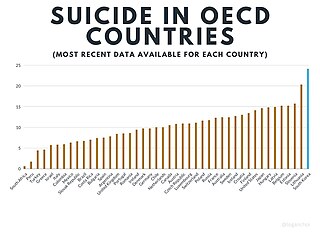
Perfectionism, in psychology, is a broad personality trait characterized by a person's concern with striving for flawlessness and perfection and is accompanied by critical self-evaluations and concerns regarding others' evaluations. It is best conceptualized as a multidimensional and multilayered personality characteristic, and initially some psychologists thought that there were many positive and negative aspects.

Suicide prevention is a collection of efforts to reduce the risk of suicide. Suicide is often preventable, and the efforts to prevent it may occur at the individual, relationship, community, and society level. Suicide is a serious public health problem that can have long-lasting effects on individuals, families, and communities. Preventing suicide requires strategies at all levels of society. This includes prevention and protective strategies for individuals, families, and communities. Suicide can be prevented by learning the warning signs, promoting prevention and resilience, and committing to social change.
Relational aggression, alternative aggression, or relational bullying is a type of aggression in which harm is caused by damaging someone's relationships or social status.
Suicide intervention is a direct effort to prevent a person or persons from attempting to take their own life or lives intentionally.

Suicidal ideation, or suicidal thoughts, is the thought process of having ideas, or ruminations about the possibility of completing suicide. It is not a diagnosis but is a symptom of some mental disorders, use of certain psychoactive drugs, and can also occur in response to adverse life circumstances without the presence of a mental disorder.
Suicide risk assessment is a process of estimating the likelihood for a person to attempt or die by suicide. The goal of a thorough risk assessment is to learn about the circumstances of an individual person with regard to suicide, including warning signs, risk factors, and protective factors. Risk for suicide is re-evaluated throughout the course of care to assess the patient's response to personal situational changes and clinical interventions. Accurate and defensible risk assessment requires a clinician to integrate a clinical judgment with the latest evidence-based practice, although accurate prediction of low base rate events, such as suicide, is inherently difficult and prone to false positives.

Belongingness is the human emotional need to be an accepted member of a group. Whether it is family, friends, co-workers, a religion, or something else, some people tend to have an 'inherent' desire to belong and be an important part of something greater than themselves. This implies a relationship that is greater than simple acquaintance or familiarity.
Self-embedding is the insertion of foreign objects either into soft tissues under the skin or into muscle. Self-embedding is typically considered deliberate self-harm, also known as nonsuicidal self-injury, which is defined as "deliberate, direct destruction of tissues without suicidal intent."
Honor suicide is a type of suicide whereby a person kills themself to escape the shame of an action they consider immoral or dishonorable, such as having had extra-marital sexual affairs, partaking in a scandal, or suffering defeat in battle. It is distinguished from regular suicide in that the subject is actively deciding to either privately or publicly kill themself for the sake of restoring or protecting honor. Some honor suicides are a matter of personal choice and are devoid of any cultural context. For example, honor suicides have been committed by military figures when faced with defeat, such as Adolf Hitler, Mark Antony, Władysław Raginis, Yoshitsugu Saito, Jozef Gabčík, Hans Langsdorff, and Emperor Theodore of Ethiopia.

South Korea has the fourth highest suicide rate in the world and the highest among OECD countries. The elderly in South Korea are at the highest risk of suicide, but deaths from teen suicide have been rising since 2010. In 2022 suicide caused more than half of all deaths among South Koreans in their twenties. It is the leading cause of death for those between the age of 10 and 39, in line with most OECD countries.
Victimization refers to a person being made into a victim by someone else and can take on psychological as well as physical forms, both of which are damaging to victims. Forms of victimization include bullying or peer victimization, physical abuse, sexual abuse, verbal abuse, robbery, and assault. Some of these forms of victimization are commonly associated with certain populations, but they can happen to others as well. For example, bullying or peer victimization is most commonly studied in children and adolescents but also takes place between adults. Although anyone may be victimized, particular groups may be more susceptible to certain types of victimization and as a result to the symptoms and consequences that follow. Individuals respond to victimization in a wide variety of ways, so noticeable symptoms of victimization will vary from person to person. These symptoms may take on several different forms, be associated with specific forms of victimization, and be moderated by individual characteristics of the victim and/or experiences after victimization.
Historically, suicide terminology has been rife with issues of nomenclature, connotation, and outcomes, and terminology describing suicide has often been defined differently depending on the purpose of the definition. A lack of agreed-upon nomenclature and operational definitions has complicated understanding. In 2007, attempts were made to reach some consensus. There is controversy regarding the phrase "to commit suicide" as some view it as implying negative moral judgment and having an association with criminal or sinful activity.
Suicide among Native Americans in the United States, both attempted and completed, is more prevalent than in any other racial or ethnic group in the United States. Among American youths specifically, Native American youths also show higher rates of suicide than American youths of other races. Despite making up only 0.9% of the total United States population, American Indians and Alaska Natives (AIANs) are a significantly heterogeneous group, with 560 federally recognized tribes, more than 200 non-federally recognized tribes, more than 300 languages spoken, and one half or more of them living in urban areas. Suicide rates are likewise variable within AIAN communities.
Maladjustment is a term used in psychology to refer the "inability to react successfully and satisfactorily to the demand of one's environment". The term maladjustment can be refer to a wide range of social, biological and psychological conditions.
Alan Lee Berman also known as Lanny Berman, is an American psychologist, psychotherapist, and suicidologist. He is an adjunct professor of Psychiatry and Behavioral Sciences at Johns Hopkins School of Medicine. Berman was formerly the executive director of the American Association of Suicidology. He is a fellow of the American Psychological Association and the International Association for Suicide Research. Berman has a private practice in psychological and forensic consultation.

The health access and health vulnerabilities experienced by the lesbian, gay, bisexual, transgender, queer or questioning, intersex, asexual (LGBTQIA) community in South Korea are influenced by the state's continuous failure to pass anti-discrimination laws that prohibit discrimination based on sexual orientation and gender identity. The construction and reinforcement of the South Korean national subject, "kungmin," and the basis of Confucianism and Christian churches perpetuates heteronormativity, homophobia, discrimination, and harassment towards the LGBTQI community. The minority stress model can be used to explain the consequences of daily social stressors, like prejudice and discrimination, that sexual minorities face that result in a hostile social environment. Exposure to a hostile environment can lead to health disparities within the LGBTQI community, like higher rates of depression, suicide, suicide ideation, and health risk behavior. Korean public opinion and acceptance of the LGBTQI community have improved over the past two decades, but change has been slow, considering the increased opposition from Christian activist groups. In South Korea, obstacles to LGBTQI healthcare are characterized by discrimination, a lack of medical professionals and medical facilities trained to care for LGBTQI individuals, a lack of legal protection and regulation from governmental entities, and the lack of medical care coverage to provide for the health care needs of LGBTQI individuals. The presence of Korean LGBTQI organizations is a response to the lack of access to healthcare and human rights protection in South Korea. It is also important to note that research that focuses on Korean LGBTQI health access and vulnerabilities is limited in quantity and quality as pushback from the public and government continues.
Suicidal ideation and suicidal thoughts are often the precursors of suicide, which is the leading cause of death among youth. Ideation or suicidal thoughts are categorized as: considering, seriously considering, planning, or attempting suicide and youth is typically categorized as individuals below the age of 25. Various research studies show an increased likelihood of suicide ideation in youth in the LGBT community.

M. David Rudd is an American psychologist and academic administrator who served as the president of the University of Memphis from 2014 to 2022.
Youth suicide in India is when young Indian people deliberately end their own life. People aged 15 to 24 years have the highest suicide rate in India, which is consistent with international trends in youth suicide. 35% of recorded suicides in India occur in this age group. Risk factors and methods of youth suicide differ from those in other age groups.
David A. Jobes is an American clinical psychologist. He is currently serving as a Professor of Psychology, Director of the Suicide Prevention Laboratory, and Associate Director of Clinical Training at The Catholic University of America. His areas of focus are on Clinical psychology, Suicide prevention, Clinical Suicidology, Ethics and Risk Management, and clinical risk assessment. In August 2022, he was awarded the Alfred Wellner Award for Lifetime Achievement by The National Register of Health Service Psychologists.






